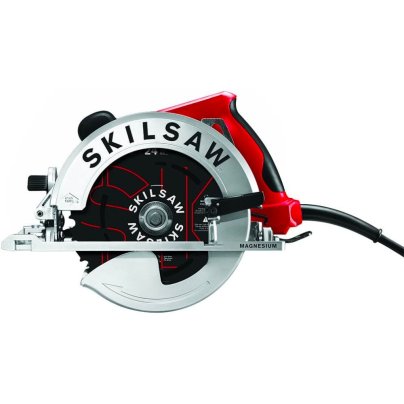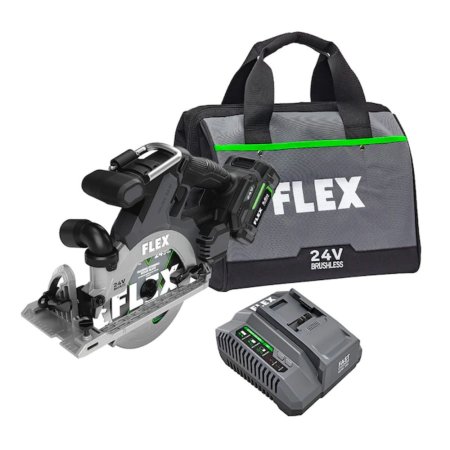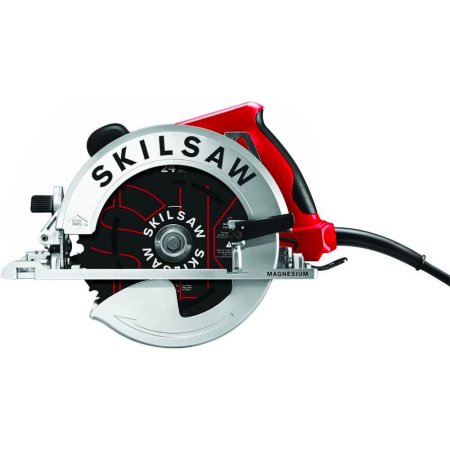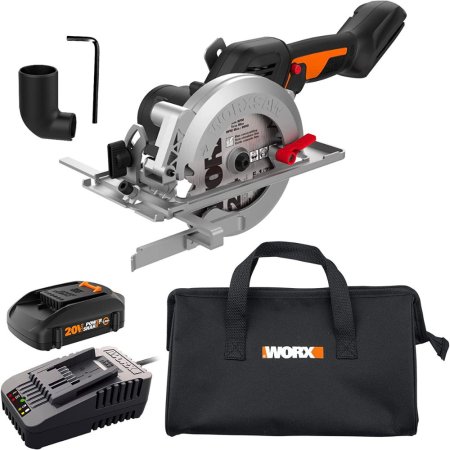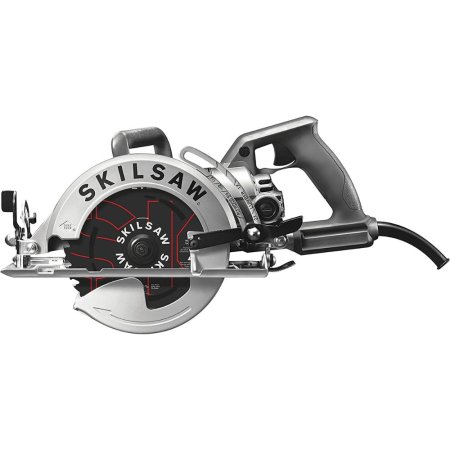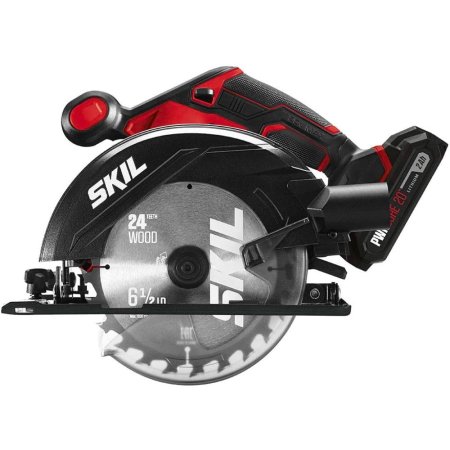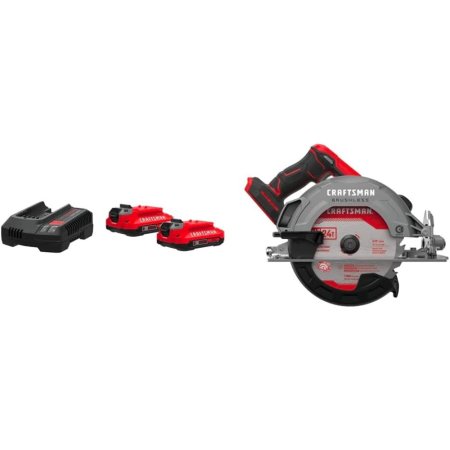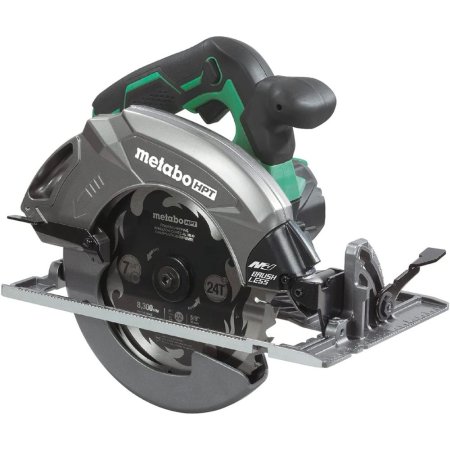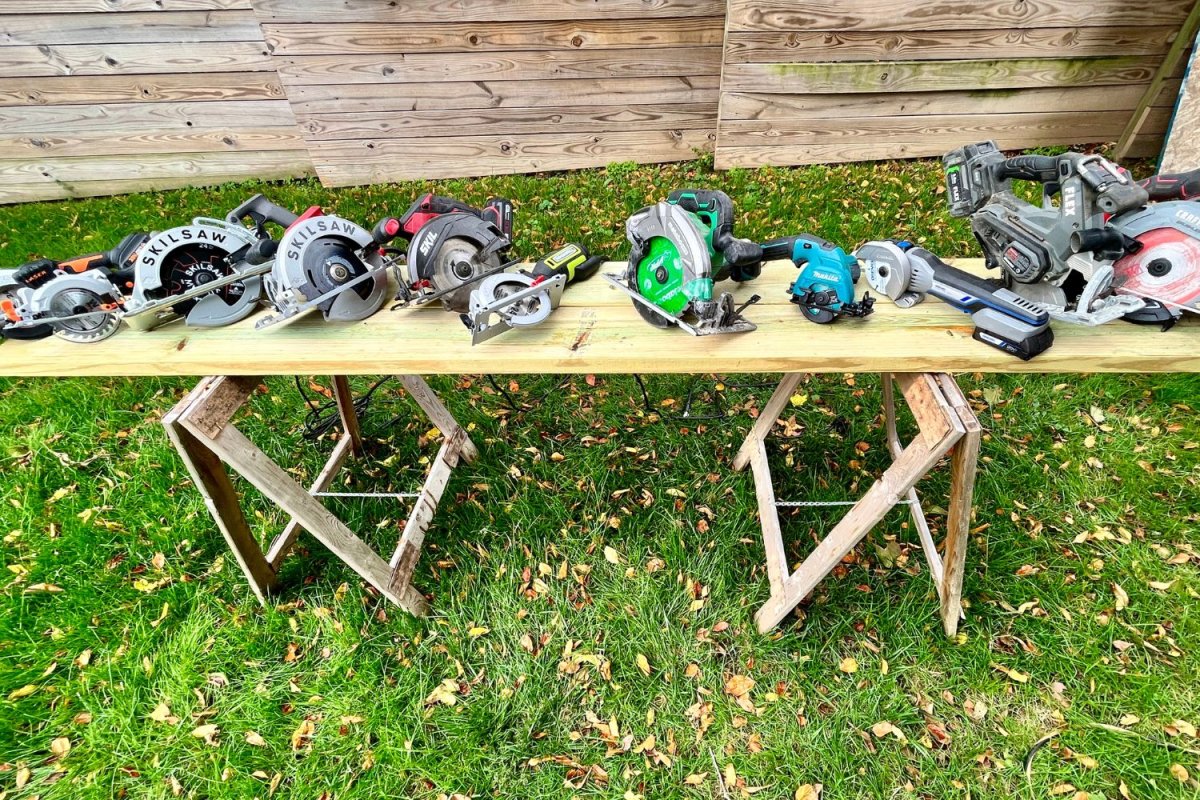
We may earn revenue from the products available on this page and participate in affiliate programs. Learn More ›
The best compact circular saws have balance, output, and ergonomics that match the work being performed, whether it’s making finicky cuts in trim or cutting rough carpentry. This guide explores some of the most essential factors to consider while shopping for this versatile tool and provides hands-on reviews of several of the top saws on the market.
A “compact” circular saw can be defined in many ways. A full-size saw that’s well designed and balanced can feel nimble and light, while a smaller tool can fight above its weight. While all of the saws in this guide are technically circular saws, there are three main categories. There’s some overlap, but the main categories are mainframe-size 6¼- and 7¼-inch circular saws that are pro level; middle-of-the-road DIY saws; and smaller units—4½-inches and under—that are niche tools.
- BEST OVERALL: Flex 6½-Inch In-Line Circular Saw Kit
- RUNNER-UP: Skilsaw 7¼-Inch Left Blade Sidewinder Circular Saw
- BEST BANG FOR THE BUCK: Worx Nitro 20V Worxsaw 4½-Inch Compact Circular Saw
- BEST FOR PROS: Makita SH02R1 12V Max CXT 3⅜-Inch Circular Saw Kit
- BEST WORM DRIVE: Skilsaw 7¼-Inch Worm Drive Circular Saw
- BEST LIGHTWEIGHT: Skil PWR CORE 20 20V 6½-Inch Circular Saw Kit
- BEST FOR DIYERS: Craftsman V20 7¼-Inch Cordless Circular Saw
- BEST MULTIMATERIAL SAW: Dremel US20V-01 20V Max Cordless Compact Saw Kit
- BEST CORDED-CORDLESS: Metabo HPT 36V 7¼-Inch MultiVolt Circular Saw
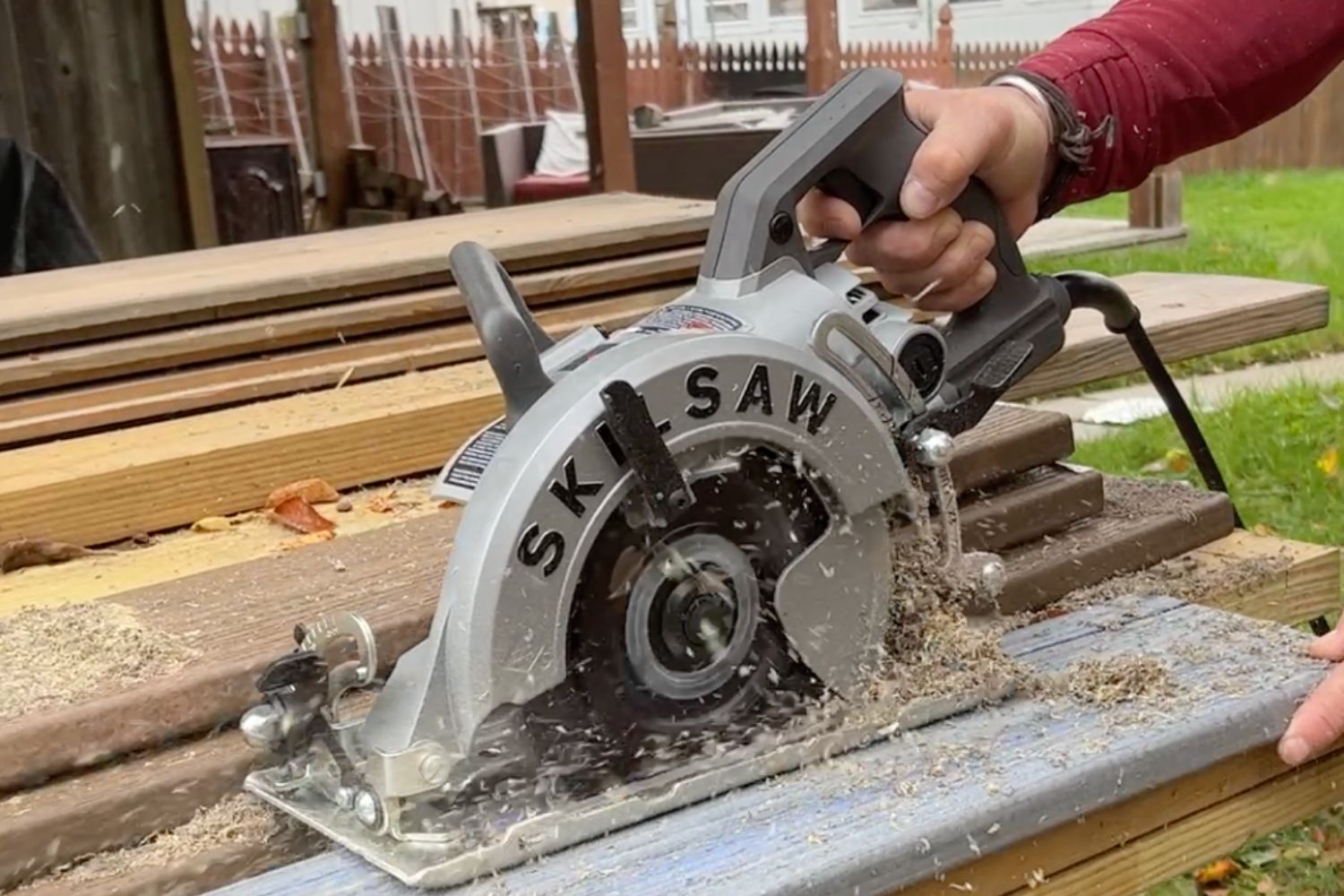
How We Tested the Best Compact Circular Saws
For this guide and the variety of saws in it, we considered as many different types of users and applications as possible, from pros to DIY enthusiasts to users already on a battery platform to beginners.
We cut composite decking, ⅝-inch oriented strand board, and 5/4 pressure-treated pine decking. We assessed power output, ability to stay on the cut line, vibration, grip, noise, and base plate (the “shoe”) durability.
We also considered what “compact” means. A small tool that’s easy to move around in tight spaces like during a kitchen remodel that suffers when making cuts is no good. Therefore, we considered size and power with other features like balance and durability.
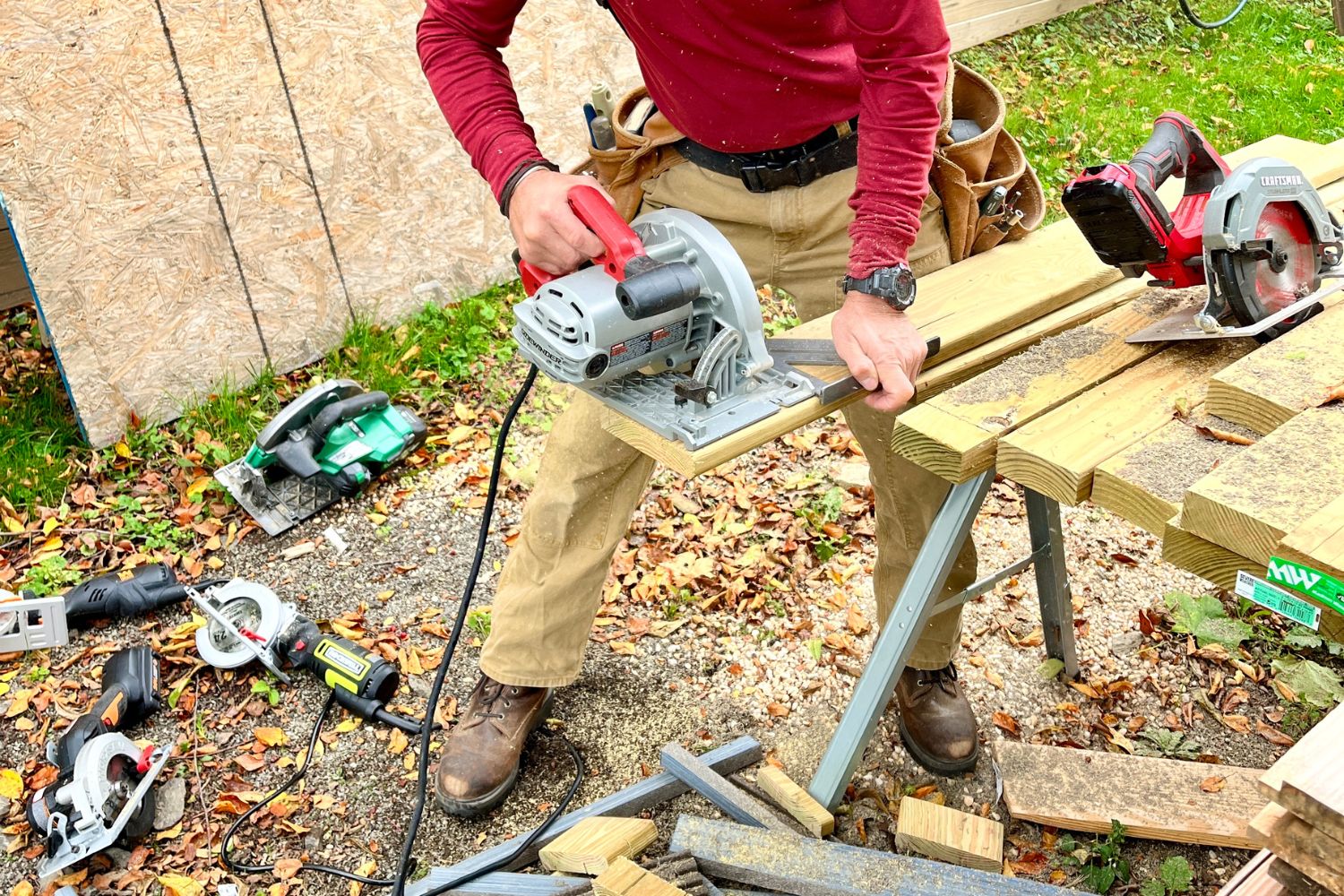
Our Top Picks
We chose the following models based on performance, affordability, and overall quality, in addition to several other criteria. Then we put them to the test to find out which ones could really “make the cut.” Keep reading to discover some of the best compact circular saws on the market.
Best Overall
Flex 6½-Inch In-Line Circular Saw Kit
Pros
- Innovative, effective design
- Available 5Ah battery provides massive runtime
- Cuts almost everything that could be found on a jobsite, such as plywood, 2-by, and doors
Cons
- At 7 pounds, it could be heavy for some users
- Might be too tall for some users as the handle rests high above the blade
Product Specs
- RPM: 5,500
- Blade diameter: 6½ inches
- Corded/cordless: Cordless24V
- Blade location: Left
This thoughtfully designed tool is an easily overlooked everyday carry for the professional and DIY enthusiast. It borrows from traditional circular saw design, and the whole is greater than the sum of its parts. With its blade-left, in-line, and upright design, most users can watch the blade cut the line. With a 5-inch shoe that’s slimmer than the typical 6½-inch shoe, it needs to be laid down on its side after use (or hung on its rafter hook). As a result, the stout aluminum shoe is further protected from being deformed from drops or hard use, which has been a typical issue with some of our circular saws. We found the saw to be quiet and smooth, and its top/rear hybrid handle makes it comfortable and easy to use.
Its 6½-inch blade makes it compact enough for 90 percent or more of the cuts needed in general home improvement and repair. Its swiveling dust port is intended for attaching to a vac; however, we found that the port can be directed to push sawdust in a desired direction, say on a windy day or simply blowing it away from the work. The included 2.5-amp hour (Ah) battery delivers good runtime. (A 5Ah battery is available, too.) Its in-line body design enables it to be used with a saw guide. It has a built-in adjustable dust ejection/collection port.
This innovative tool offers near full-size power and cut capacity packed into a creative, functional design.
Get the Flex compact circular saw at Lowe’s or Acme Tools.
Runner-Up
Skilsaw 7¼-Inch Left Blade Sidewinder Circular Saw
Pros
- Super-durable design with a magnesium housing and shoe make for a dependable tool
- Blade-left design is ideal for those who are right-handed
- Well-balanced and lightweight design makes it easy to use
Cons
- No electric brake can be a disappointment for some
- No soft start, which is a feature some DIYers enjoy
Product Specs
- RPM: 5,300
- Blade diameter: 7¼ inches
- Corded/cordless: Corded
- Blade location: Left
The Skilsaw left-blade circular saw is equally at home on a framing site, a remodeler’s job, or in a home workshop. Budget-friendly, it’s amply designed without a single frill. There’s no vacuum port, soft start, or electric brake, and that was just fine with us.
First, the blade orientation is ideal for right-handed users, and the compact direct-drive design means it can handle working in cramped spaces like cutting studs in a basement or working in a kitchen remodel. It’s also equally at home on a set of sawhorses on a deck-building project. Its magnesium shoe takes weight out of the tool while adding durability, which is a real advantage for people who are tough on their tools.
The 10-foot cord is awesome, flexible, and easy to wrap around the saw for storage. We found the lines of sight to the blade to be totally uninhibited. Plus, the tool is extremely well balanced, making it ideal for cutting in cramped spaces like a recent kitchen we remodeled or when working on sawhorses building a deck. We like it because it’s lots of saw for not a lot of money.
Get the Skilsaw left-blade compact circular saw at Amazonor Ace Hardware.
Best Bang for the Buck
Worx Nitro 20V Worxsaw 4½-Inch Compact Circular Saw
Pros
- Surprising power for a small tool, muscling through all of the test materials
- Lightweight design makes it easy to use for long periods
- Easy to handle cutting across sheet goods and dimensional lumber
- Well-balanced design enables the user to focus easily on the job at hand
Cons
- Unlike others that offer kits, this only comes with 1 battery
- Low amp-hour battery at 2Ah, which is comparable to some but less than others
Product Specs
- RPM: 6,900
- Blade diameter: 4½ inches
- Corded/cordless: Cordless
- Blade location: Left
For small jobs, occasional use, and specialty cuts, this saw’s outstanding power and cord-free setup really perform. The 20V 2Ah battery and brushless motor (which works more efficiently than standard, brushed cordless tools) spin the blade fast, and it delivered excellent cutting for a small saw in materials as thick as 2×4 during our hands-on tests.
The tool runs quietly. The neck of the saw is thin and ideal for reaching the release switch and trigger while positioning the saw on the cut line. It handily cuts sheet goods, 1-by, and 2-by lumber. It’s a lot of saw in a small package at a good price.
Get the Worx compact circular saw at Amazon, Ace Hardware, The Home Depot, or Lowe’s.
Best for Pros
Makita SH02R1 12V Max CXT 3⅜-Inch Circular Saw Kit
Pros
- Lots of power packed into a small saw
- Ideal for particular applications like cutting cabinet backs and other thin materials
- Light weight makes it easy to use and store
- 2 batteries plus a charger in the kit are a great value
Cons
- May be too specialized; a niche tool for some
- Requires small Makita batteries that may be incompatible with other Makita tools
Product Specs
- RPM: 1,500
- Blade diameter: 3⅜ inches
- Corded/cordless: Cordless
- Blade location: Right
The Makita compact circular saw weighs just 3½ pounds, but it can drive the 3⅜-inch wood blade at up to 1,500 rpm through plywood, medium-density fiberboard, pegboard, particleboard, melamine, and drywall at a maximum depth of 1 inch. The cordless saw kit also includes a blade, battery charger, two batteries, and a carrying case to protect each item.
Any kitchen, bath, flooring, or millwork installer would keep this tool on their truck, in our opinion. Because of its small size, it would be a great tool for cutting out cabinet backs or bases, plunge cutting flooring for a heat register, or oddball cuts in remodels where dust is an issue. This saw—with its two batteries and included charger—is a lightweight, nimble, get-out-of-jam-free card.
Get the Makita compact circular saw at Amazon, Ace Hardware (tool only), or The Home Depot.
Best Worm Drive
Skilsaw 7¼-Inch Worm Drive Circular Saw
Pros
- Purpose-built for professional use
- Long in-line body for drop cutting deck joists and rafter tails as well as reaching across plywood
- Tough, durable design can handle repeated drops
Cons
- At just more than 14 pounds, it may be too heavy to manage safely for some users
- Stamped steel shoe can deform from dropping
Product Specs
- RPM: 5,300
- Blade diameter: 7¼ inches
- Corded/cordless: Corded
- Blade location: Left
The phrase “worm drive” is derivative of an engineering term and means that the tool’s primary drive component is what’s called a “worm gear,” which is composed of interlocking helixes that transfer the motor’s power to the spinning of the blade. It’s heavy and nearly impossible to wear out.
Is it more powerful or durable than direct drives? Maybe. Pros and DIYers argue about this, but that might be missing the point. Worm-drive saws have in-line bodies and mount the blade left—so righties can see it cut.
Worm drives are awkward, longer than sidewinders, and rather front heavy, but their front-heavy design is what makes them so great. Carpenters can use the saw’s length and weight to reach across a sheet of plywood or drop cut deck joists in place and cut framing boards off the stack while building a house or addition.
During our tests, the Skilsaw delivered on all the features that make a circular saw great. It’s got a stamped steel plate, which may deform from repeated drops, but the rest of the tool is purposefully designed to build.
Get the Skilsaw worm-drive compact circular saw at Amazon, Ace Hardware, Lowe’s, or Acme Tools.
Best Lightweight
Skil PWR CORE 20 20V 6½-Inch Circular Saw Kit
Pros
- Blade left, which is good for right-handed users
- Lightweight design at 3 pounds makes it easy to handle
- Blade is easy to see, which helps with precision cuts
Cons
- Only comes with 1 battery
- Included battery is a low amp-hour battery, which limits length of use in each session
Product Specs
- RPM: 4,500
- Blade diameter: 6½ inches
- Corded/cordless: Cordless
- Blade location: Left
With its 20-volt (V) battery, we found that this 6½-inch compact circular saw has enough power for cutting larger materials like 2x4s and sheet goods. However, at 2Ah (think of volts as the gasoline and amp hours as the size of the tank), it can’t do it for long. Plus, it had to work hard the whole time during our tests. (Though, according to the product manual, higher-amp batteries are compatible and sold separately.)
The tool has basic light-duty adjustments and a stamped steel shoe that make it a go-to for periodic DIY work like replacing some deck boards, trimming a door, cutting a few fence posts, or building a compost bin. The blade is not so hot and the tool only comes with one battery, so unless the user has other Skil batteries to swap in, runtime is limited.
The 6½-inch blade is small; however, 6½-inch blades can handle 90 percent of what needs to be cut. The unit is small and well balanced.
Get the Skil compact circular saw at Amazon, Lowe’s, or Acme Tools.
Best for DIYers
Craftsman V20 7¼-Inch Cordless Circular Saw
Pros
- Work light can be helpful for accuracy in dark environments
- Good lines of sight to the blade helps efficiency
- Light weight makes it easy to carry on and off a project
Cons
- Not super powerful and can feel a little hollow while working through tough material
- Low amp-hour battery can limit each session’s use
Product Specs
- RPM: 4,700
- Blade diameter: 7¼ inches
- Corded/cordless: Cordless
- Blade location: Right
This bare-bones 20V 7¼-inch circular saw is suitable for basic, periodic use. We found that it has enough power to handle 2-by material for tasks such as framing basement walls, building a treehouse, or building a fence, but it struggles in tough materials like pressure-treated lumber.
While the kit comes with two 2Ah batteries and a charger, they are still small batteries with limited runtime. The adjustments are all basic stamped steel. And while the tool is very light, it feels almost hollow. A lot of that has to do with refinements in tech that make the electronics and gearing in newer tools, but our hands-on testing revealed that it’s also light enough that it can be felt when the tool is struggling to make a cut.
The shoe is stamped aluminum. The trigger is comfortable to use, but the saw’s balance is nothing special. For periodic DIY projects around the house, such as cutting deck boards or top caps, repairing fence slats, and other weekend work, the saw functions.
Get the Craftsman compact circular saw at Amazon.
Best Multimaterial Saw
Dremel US20V-01 20V Max Cordless Compact Saw Kit
Pros
- Multimaterial cutting saw cuts wood, drywall, masonry, metals
- Versatile in tight spaces and with odd material
- Powerful with high rpm and 20V can muscle through varied material like drywall, metal, or wood
- Comes with various blades included in kit
Cons
- Only comes with 1 battery, which limits runtime, but can be purchased with 2
- Low amp-hour battery limits length of use per session
Product Specs
- RPM: 15,000
- Blade diameter: 4 inches
- Corded/cordless: Cordless
- Blade location: Left
While 7¼-inch circular saws’ wood-cutting blades can be swapped out for concrete/masonry blades, and soft metals like aluminum can be cut with a circular saw, circular saws are designed primarily to cut wood. The Dremel is designed and packaged as a multimaterial saw, and it is as handy at cutting wood as it is metal or even drywall.
The saw ships with a multimaterial “blade.” It’s really more of an abrasive wheel that can cut laminate, melamine, sheets goods, wood, drywall (if cutting drywall, combine it with a vacuum as there’s a lot of dust), plexiglass, plastic, and lots of other things. It also ships with an abrasive wheel that can cut metals and a diamond wheel that can cut hard items like tile or a marble threshold. And it has a kit bag to hold all of this as well as the charger.
Though it’s unlikely to be used every day, we think it’s still an extremely handy tool to have around for oddball cuts in a variety of materials, including drywall, plexiglass, metal, and plywood.
Get the Dremel compact circular saw at Amazon, The Home Depot, or Lowe’s.
Best Corded-Cordless
Metabo HPT 36V 7¼-Inch MultiVolt Circular Saw
Pros
- Flexible corded/cordless operation allows users to change how it’s powered
- Good lines of sight to the blade help with accuracy
- Soft start, which is preferred by some users
- Smooth operation in tough materials
Cons
- Adapter, battery, and charger sold separately
- Basic adjustment levers, which work fine but aren’t as advanced as others
Product Specs
- RPM: 4,300
- Blade diameter: 7¼ inches
- Corded/cordless: Multivolt; corded and cordless
- Blade location: Right
Metabo HPT’s 36V corded/cordless top-handle blade-right circular saw is made for operation on its 36V battery platform or powered up through an adapter that plugs into the wall or an extension cord.
Lines of sight to the blade are good; the handle is comfortable, and there are no issues exchanging the battery or adapter (sold separately). Runtime for the 36V 4Ah battery was excellent during testing. While the stout aluminum shoe isn’t the toughest, we found that it’s among the most robust in the group and makes the saw feel lightweight without feeling hollow.
The tool ran smoothly and ejected dust out of the right-mounted dust port. This saw can be hooked up to a vacuum with the included adapter. We found smooth, powerful, and professional performance in all the materials we cut with this saw.
Get the Metabo compact circular saw at Amazon or Acme Tools.
ALSO TESTED
The 4½-inch compact circular saws by Worx, Rockwell, and Wen that we also tested were small and ideally designed for smaller hands, smaller projects, or occasional use. However, each seemed to have a design issue that made the otherwise nice notion of an easier-to-operate saw seem somewhat of a missed opportunity. Each of them struggled in all but the thinnest, least dense test materials.
The Rockwell worked noticeably hard to make it through the test materials. It also has a stout handle, making engaging the trigger something of a challenge. The Wen was about as light duty as could be expected and also had trouble managing the test materials. The Worx stout body made engaging the trigger and trigger release challenging, and it made the saw awkward to use.
What to Consider When Choosing the Best Compact Circular Saw
Whether cutting through sheet metal, repairing a deck, making a shelf, or removing an old shed, using a compact circular saw—paired with the correct blade—is an essential tool for getting these jobs done.
Before buying a new compact circular saw, consider factors such as motor type, speed, and amperage as well as the potential need for the power of a corded model or the increased mobility of a cordless circular saw.
Sidewinder vs. Worm Drive
There are generally three types of circular saws: Direct drive, also called “sidewinders” because the motor sticks out the side; worm drive, which refers to a helical gear in the tool that drives the blade; and belt drive, where a gear turns a belt.
Sidewinder circular saws (sidewinders) with a direct-drive motor tend to be shorter and stouter tools than other types. It’s the classic circular saw setup that most people probably envision when they think of a circular saw. The blade is typically on the right side of the tool, though there are blade-left models.
Worm-drive circular saws are typically long and front heavy. The tool has what’s called an in-line design, and while it’s not really the best saw for a home workshop, professional framers and deck builders use this long tool body and weight to their advantage. Worm drives are said to have more power and durability than direct drives, but a lot of that is enthusiast talk and passion from users who love and depend on their tools.
Belt-drive circular saws aren’t compact saws. Used in workshops, they use a belt-and-pulley system to power the blade. Unlike compact saws, these are made to tackle denser and thicker material.
Corded vs. Cordless
As with many power tools, a compact circular saw can either be connected to an electrical outlet with a power cord or powered with a battery for cordless operation.
Corded compact circular saws are still the king of the jungle when it comes to uninterrupted power and dependable “go-now” performance. Sure, cords must be run. And they can be tripped over and need to be managed. But for “all-day go,” the cord is still king.
Cordless compact circular saws have surprising power and runtime. They’re typically more than suitable for home workshop projects, occasional use, and professional output of the design details.
Speed and Amperage
Speed and amperage are both measurements that can be attributed to the motor. Speed is measured in revolutions per minute (rpm) and is generally higher for sidewinder circular saws. The best compact circular saw offers a balance of speed and torque so the blade cuts cleanly through a wide range of materials.
Amperage (amp) refers to how much electrical power a motor draws from the power source. The amperage rating is not a measure of power—that’s marketing lingo. It’s just a measure of how much electricity it consumes. Compact circular saws range in amperage from a small 4-amp motor to a 15-amp motor that is more common with standard-size circular saws.
Blade Size and Types
Blade size is another defining measure of the tools in this category. The 7¼-inch is the standard or what might be considered full-size. The 6¼-inch tools are just a bit smaller than full-size 7¼-inch tools but cut about 90 percent of what the larger, heavier saws cut and are worth consideration. The 4½-inch and under compact circular saws tend toward specialized uses.
The 6¼- and 7¼-inch tools can cut most wood building materials and, with a blade switch, concrete. These are the go-to platforms for general use, such as cutting 2x4s or plywood for building a shed or cutting pressure-treated lumber for building a deck. For the most part, they can only run wood-cutting and concrete-cutting blades. On the other hand, the smaller tools in the category can only cut thin, light material with very few exceptions.
Safety Features
When using a power tool, pros and DIYers alike should rank safety as a priority. To help users reduce the risk of injury, some compact circular saws contain retracting blade guards and blade brakes that bring the blade to a quick stop when the trigger is released.
Cordless circular saws usually incorporate a trigger release, so the blade doesn’t start up unless both switches are pressed. This prevents accidental starts from a slip of the finger or from the saw moving in a tool box or bag. Another feature is a built-in vacuum port that allows a small vacuum hose to connect to the saw to pull dust and debris from the work area, increasing visibility and improving air quality.
Additional Features
While the main features of the best compact circular saws are the type of blade and motor power, several extras can make this tool much easier to use:
- Laser guides are typically mounted on the top of the compact circular saw so the laser is directed down at the surface of the material being cut. For the most accurate cuts, with or without a laser, users should simply watch the blade on the cut line.
- Bevel and depth adjustments to the blade allow users to change the cutting angle and depth as well as customize the project to meet desired results. It’s best to have a full blade gullet under the work, but not much more.
- Protective carrying cases protect the compact circular saw and accessories, like batteries and chargers, and keep them neat and organized.
FAQs
Working with a compact circular saw provides more freedom of movement, which makes accurate cuts easier. Remember that any power tool can be a hazard when used incorrectly. To learn more about these powerful and versatile tools, take a look at some of the most frequently asked questions about compact circular saws.
Q. How deep can a 7¼-inch compact circular saw cut?
A compact circular saw designed for a 7¼-inch blade can cut to a maximum depth of 2½ inches.
Q. Can I cut concrete with my compact circular saw?
Yes, you can cut concrete with a compact circular saw if it is equipped with a diamond blade.
Q. How do I maintain my compact circular saw?
Properly maintaining a compact circular saw isn’t difficult. Follow these guidelines to take care of your tool:
- Inspect the circular saw before use to ensure the power cord isn’t frayed and the battery isn’t leaking.
- Check the blade to ensure it’s secured.
- After use, clean the blade to prevent rusting and clean the saw with a vacuum to remove any accumulated dust.
- Store the circular saw in a safe location with low humidity to help prevent rusting and corrosion.
Q. How long will my compact circular saw last?
A compact circular saw can last between 10 and 20 years if it is properly maintained.

